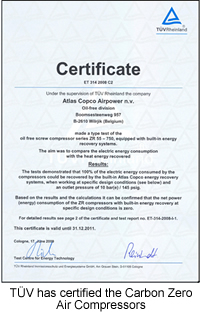Compressed Air Best Practices spoke with Peter Kyriacopoulos. Mr Kyriacopoulos is the General Manager/VP USA Region East for Atlas Copco Compressors.
Good afternoon. What is a “carbon zero air compressor”?
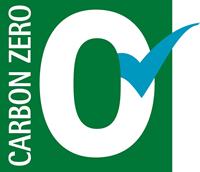 A “carbon zero” air compressor has a net energy consumption equaling zero. The installation and operation of a “carbon zero” air compressor gives users the ability to recover the energy used in compressing air, meaning 'net zero' energy consumption in the facility. The net CO2 greenhouse gas footprint, therefore, is also zero. Therefore the name of “carbon zero” air compressors.
A “carbon zero” air compressor has a net energy consumption equaling zero. The installation and operation of a “carbon zero” air compressor gives users the ability to recover the energy used in compressing air, meaning 'net zero' energy consumption in the facility. The net CO2 greenhouse gas footprint, therefore, is also zero. Therefore the name of “carbon zero” air compressors.
Our customers are driven to improve the Sustainability of their operations. Reducing their carbon dioxide emissions is a high priority for them and reducing their energy use is an important tactic in meeting their goals. While compressed air systems account for an average of approximately 10 percent of all industrial electricity consumption, compressed air costs can be as high as 40 percent of a plant’s electricity bill.
How can an air compressor consume “net zero” power?
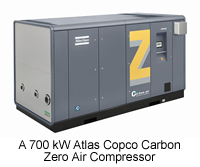 In simplest terms, the electrical power required to run a water-cooled air compressor can be recovered in the form of hot water to be used in another process. Atlas Copco’s Oil-free Air division has taken this “heat recovery” philosophy and integrated it into the company’s ZR Series of water-cooled, oil-free air compressors.
In simplest terms, the electrical power required to run a water-cooled air compressor can be recovered in the form of hot water to be used in another process. Atlas Copco’s Oil-free Air division has taken this “heat recovery” philosophy and integrated it into the company’s ZR Series of water-cooled, oil-free air compressors.
Hot water or steam is normally generated using industrial boilers that consume electricity or fuels like heating oil or natural gas. When using hot water from the compressor, either directly or as pre-heated boiler feed water, the consumption of fuel can be either dramatically reduced or be eliminated. This results in significant energy savings.
 |
||||
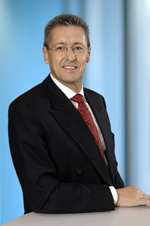 |
"Atlas Copco's continuous investments in innovation are more important than ever in these difficult times, in both supporting our customers in improving productivity and reducing energy costs. - Ronnie Leten, President and CEO, Atlas Copco Group |
|||
TÜV tested the net energy consumption?
Yes. While our R&D efforts had confirmed the results, we felt it was important to receive third-party verification of this important advancement.
The independent Technische Überwachungs-Verein (German Technical Monitoring Association, or “TÜV”), therefore, supervised the type-testing of Atlas Copco’s ZR 55-750 kW water-cooled, oil-free screw compressors, equipped with built-in energy recovery systems.
The testing process involved real-time measurement of the electrical power input and the output power as hot water. The two measurements were then compared. It was proven that under the specific design conditions of 104 F and 70 percent relative humidity, 100 percent of the input electrical power could be recovered in the form of hot water.
The test results demonstrate that the ZR Series oil-free air compressors, with built-in energy recovery systems, are the first in the world to be TÜV certified for net zero energy consumption. In specific design conditions, 100 percent of the electrical power needed to run an Atlas Copco ZR 55-750 kW water-cooled, (up to 900 kw VSD) oil-free screw compressor can be recovered in the form of hot water.
What industries/applications can take advantage of the hot water and steam?
Most industries can make use of hot water for space heating and showers. However, the industries that will benefit the most are those that have a continuous need for hot water and steam in their processes. Typical process hot water and steam users include:
- food and milk processing plants (scalding, cleaning, sterilization, and melting)
- pulp and paper industry (in the digester and evaporators, in bleaching and pulping)
- textile industry (dyeing, and stabilization of manmade fibers)
- pharmaceutical industry (fermentation and sterilization)
- refineries, chemical and petrochemical plants (steam distillation, enhanced recovery, stripping, and heat tracing)
- power plants (electricity generation)
- clean rooms (humidification)
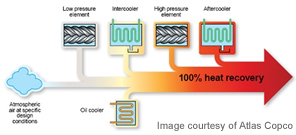
Please describe how this “heat recovery” feature functions in the air compressor.
When an Atlas Copco Carbon Zero compressor compresses air, the input electrical energy is converted into heat. This heat appears at the low-pressure and high-pressure compression elements, the oil cooler, intercooler and aftercooler. The built-in energy recovery system circulates cooling water through all of these components and, as a result of the heat transfer, yields hot water at up to 90°C ( 194 F). The efficient coolers also help to collect the heat energy in the incoming air (through latent heat of condensation).
Here is a more specific example of where the heat is recovered within the air compressor. A Carbon Zero compressor working at 145 psig with inlet water temperature of 68 F will recover the heat as follows.
| Oil Cooler | 12% | ||
| Compression elements | 9% | ||
| Intercooler | 37% | ||
| Aftercooler | 42% |
What happens to heat recovery under different operating conditions?
At higher temperatures (than 40 C 104 F) and higher relative humidity (70%) it is even possible to recover more than 100 percent of the electrical energy input. In the average manufacturing environment, with lower temperatures and relative humidity, the recovery will amount to 90 - 95 percent.
How is the carbon zero compressor different than a standard Z Series air compressor?
In the standard Z Series compressor, efforts are taken to reduce outlet water temperatures so that they average 120 – 130 F at the outlet. Most customers don’t want the outlet water to be too hot (if they aren’t going to use it)!
The Carbon Zero air compressor deploy an engineered modification to how we route the water through the air compressor. Mechanical control components have been added as well as modified water circuits.
What do the Returns-on-Investment look like?
This is the exciting part. Not only does the Carbon Zero air compressor provide a “Win” to the Sustainability efforts of the user, the ROI’s are so compelling that they also provide a “Win” to the bottom line of the facility.
A 750 kw (1000 hp) carbon zero compressor, for example, can save a facility \$320,000 per year in costs previously generated by the heating oil used for boiler feed water. This example assumes a boiler efficiency of 90%, a cost of \$2.00 per gallon of heating oil, consumption of 20 gallons per hour of fuel, and 8000 working hours per year.
In this size, the investment required would be less than \$50,000 for the heat recovery module plus \$50-75,000 for a pumping skid to deliver the hot water to its’ destination. Return-on-investment, in this conservative scenario, is less than six months for the customer.
For more information please contact Peter Kyriacopoulos, Atlas Copco Compressors, tel: 518-573-9716, email: peter.kyriacopoulos@us.atlascopco.com, www.carbonzerocompressors.com

